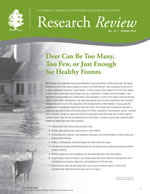
Northern Research Station
11 Campus Blvd., Suite 200
Newtown Square, PA 19073
(610) 557-4017
(610) 557-4132 TTY/TDD
- Todd Ristau
Research Ecologist - Alex Royo
Research Ecologist - Susan Stout
Project Leader / Research Forester - Scott Stoleson
Research Wildlife Biologist - Mary Beth Adams
Research Soil Scientist - W. Keith Moser
Research Forester
Deer can be too many, too few, or just enough for healthy forests

Northeastern and midwestern forests are inhabited by large populations of white-tailed deer, the largest herbivore in most of the region (except for moose in the North Woods). Deer populations at the time of European settlement in areas of “prime habitat” (3 million square miles) ranged from 8 to 20 per square mile and seem to have been kept at these levels by a combination of human and wild predation. Later deer were hunted privately and commercially to near extirpation in much of the eastern forests by the late 1800s to early 1900s. Subsequently, deer were reintroduced and since then populations have increased dramatically across much of the range due to the increased extent of their habitat. In many places the populations are considerably higher than historical levels. This increase has resulted from regrowth of abandoned agricultural lands and forests clearcut for timber, extirpation of top predators (wolves, mountain lions, and bears), as well as rigorously enforced hunting laws designed to keep deer numbers high for modern hunters.
View the Spring 2012 Research Review (1.1 MB PDF)
For more information contact
Rebecca Nisley
Newsletter Editor
USDA Forest Service - Northern Research Station
51 Mill Pond Road
Hamden, CT 06514
203-230-4338
Last Modified: 08/29/2011